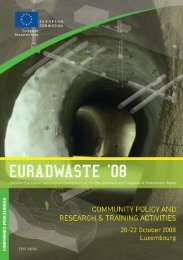EU industrial structure - EU Bookshop - Europa
EU industrial structure - EU Bookshop - Europa
EU industrial structure - EU Bookshop - Europa
You also want an ePaper? Increase the reach of your titles
YUMPU automatically turns print PDFs into web optimized ePapers that Google loves.
<strong>EU</strong> <strong>industrial</strong> <strong>structure</strong> 2011 — Trends and Performance<br />
FIgURE III.1: Value added — average annual growth rate in the <strong>EU</strong> in 1995 – 2009 (%)<br />
58<br />
Electrical and optical equipment<br />
Transport and communication<br />
Health and social work<br />
Financial intermediation<br />
Chemicals<br />
Real estate and business activities<br />
Education<br />
Rubber and plastics<br />
Wholesale and retail trade<br />
Transport equipment<br />
Machinery n.e.c.<br />
Other services<br />
Total<br />
Basic metals and metal products<br />
Manufacturing<br />
Hotels and restaurants<br />
Activities of households<br />
Non-metallic mineral products<br />
Other mining<br />
Pulp, paper and publishing<br />
Construction<br />
Other manufacturing<br />
Agriculture, hunting and forestry<br />
Wood and wood products<br />
Electricity, gas and water supply<br />
Food, drinks and tobacco<br />
Rened petroleum<br />
Fishing<br />
Textiles and clothing<br />
Public administration<br />
Mining and quarrying<br />
Mining of energy products<br />
Leather and footwear<br />
Note: Growth rates refer to value added in constant prices.<br />
Source: own calculations using Eurostat data.<br />
In analyses of growth in terms of production it should<br />
be taken into account that production differs from value<br />
added since intermediate consumption is included.<br />
Production measurements in real terms are only available<br />
for manufacturing sectors in the data sources used in this<br />
publication. <strong>EU</strong> average annual production growth rates<br />
in 1995‑2010 are very different across sectors. Growth<br />
in the more ‘traditional’ and labour‑intensive sectors<br />
declined more than in other sectors. Declining annual<br />
-4 -3 -2 -1 0 1 2 3 4 5 6 7 8<br />
production growth rates in 1995‑2010 can be witnessed in<br />
leather and footwear, clothing, tobacco and textiles where<br />
growth declined on average by between 2.5 % and 5 %<br />
in 1995‑2009. Conversely, the highest growing sectors<br />
tend to be more capital‑intensive. Average production<br />
growth in 1995‑2010 was the highest in pharmaceuticals,<br />
computer, electronic and optical products and in motor<br />
vehicles where growth increased by between 3 %<br />
and 5.4 %, cf. Figure III.2.
















